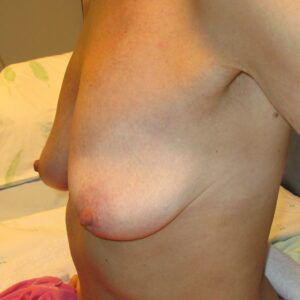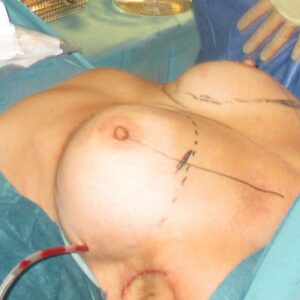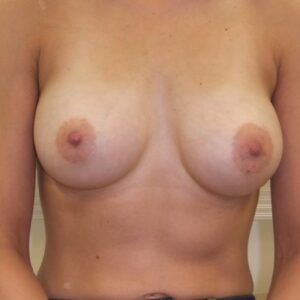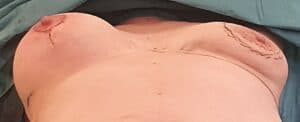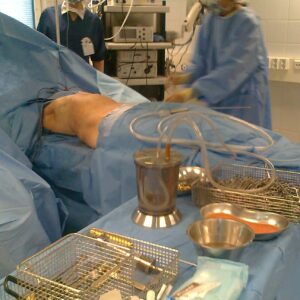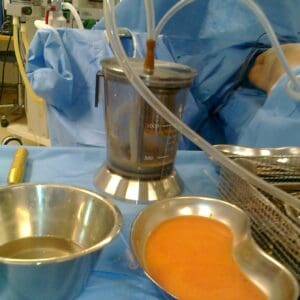Breast Augmentation
There are various different methods available for breast augmentation. Breast augmentation might be an option for you if you feel that the size or shape of your breasts has altered significantly in the course of the years or you think that it might give you a positive boost in self-esteem.
Breast Augmentation with Implants
Breast augmentation surgeries with an implant attempting to increase the breast size were made as far back as the nineteenth century. Today breast enlargement is a widely spread operation.
Slim women generally have too little tissue of their own for transplantation. Then the best method of breast correction is a silicone prosthesis or implant.
There are numerous kinds of implants. We favour soft-touch, shaped models that do not leak. We select the implant according to the patient’s breast and chest size as well as her wishes.
We use endoscopic technique!
Endoscopic Technique
The implants are inserted through incisions in the armpits using an endoscopic technique, thus leaving no visible scarring on the breasts.
The shaped implant is inserted under the patient’s own breast. If the skin and adipose layer in the breast area are too thin, the implant is placed under the pectoral muscle.
The patient’s pectoral muscle will not always be enough to cover the lower part of the implant. Therefore, special methods have been developed to support the lower part of the breast; an example of these is the acellular tissue matrix. Without sufficient support, the breast implant can drop down after a while and cause an ugly double fold in the lower part of the breast. This is however rare when an armpit incision is used.
Photo: Implant through the axillary wound
Photo: Breast augmentation through armpit before and after.
Breast augmentation through mamilla incision: left breast before and right breast after the augmentation
Breast Augmentation Operation
Breast augmentation surgery is performed under general anaesthesia and takes 2–3 hours. After the surgery the patient stays overnight at the clinic and is discharged the following morning. Recovery takes about three weeks.
During the surgery, the surgeon places the drains (catheters) under the breast and the possible tissue fluid produced under the wound is drained through them. The drains stay in place as long as there is drainage (1–7 days).
We recommend using painkillers right after the operation because breasts are sore in the beginning. Drains are left in place for 5-7 days until liquid excretion ends. We use a breast band in the upper part of the breasts for two weeks. It prevents the implant from moving upwards until it has become attached to its right place. Normal exercise helps general blood circulation and healing.
Breast Augmentation Aftercare
After the surgery, you should avoid physical exertion until the stitches are removed (8 days).
During the surgery, drains (catheters) are placed under the breast through which the possible tissue fluid produced under the wound is drained. The drains stay in place as long as there is drainage (1–7 days).
You can take a shower two days after surgery.
To support the implants a prosthetic belt should be worn for two weeks. You can return to work a week after the surgery.
Possible Post-operative Complications
On the first days after the surgery, the breasts may be painful. Therefore you should avoid driving a car for a few days immediately after the surgery. A security belt should not press the newly operated breast.
Common postoperative complications, such as bleeding or wound infection, may also occur in conjunction with breast enlargement surgery. However, they are rare. The treatment of these complications is included in the price of the surgery.
The cost of treating possible scar contracture around the implant is not included in the price.
Possible Problems
A breast implant does not prevent breastfeeding. Silicone is a well-tolerated substance and widely used in medical applications such as catheters, etc. The fact that silicone is not a biologically living tissue might cause problems. There is no blood circulation to it, and sometimes the body begins to reject such tissue.
Encapsulation
The body can form a protective shell, or a capsule, around the implant and this capsule can become so thick that it starts squeezing the implant. This will cause pain in the breast and can also change its shape.
At present, it is commonly believed that encapsulation of the breast implant can be caused by bacterial colonization. Bacterial colonies can grow a biofilm that is resistant to antibiotics around the implant. In our surgical technique, we pay special attention to the prevention of biofilm formation: during the surgery, the implant is washed and soaked in an antibiotic solution.
According to surveys, encapsulation occurs in approx. 5 – 20% of implant cases. A few per cent of these cause pain and changes in the breast shape so that the implant has to be removed. The non-biological material of the implant can also become contaminated and cause a bacterial infection. To treat the infection the implant usually needs to be removed. Fortunately, such bacterial inflammations are very rare.
ALCL
Most recently, it has also been discovered that a larger number of textured implants than smooth implants have been associated with cases of ALCL (aggressive large cell lymphoma), although smooth implants do also carry a risk of ALCL. It is very rare. It produces liquid or grows a tumour around the capsule, that is easy to find in ultrasound-examination. If we found the problem at an early stage, the capsulectomy and implant removal is enough to cure the patient.
It is important that breasts with implants be checked every year or two. As a safety measure, a breast ultrasound examination will be sufficient. If there is a fluid build-up or capsule-thickening around the prosthesis, a biopsy should be taken. In this case, a breast MRI will also be necessary. If no symptoms or abnormalities are observed, the patient can continue to live with the implants and enjoy the physical transformation that they have provided.
Breast Augmentation with Fat Transfer (Adipose Tissue Transplantation)
Breast enlargement involves transplantation of adipose tissue (fat tissue) from other parts of the body.
This technique is still being developed, and it is not yet known, for example, which proportion of the transferred fat cells survive, whether fluid (seroma, oil cyst) accumulates in the treated area and whether there are other adverse effects. The new liposuction technique whereby fat cells are released by means of a water jet appears to be a more gentle and effective method of adipose tissue transplantation.
The abdominal area is the easiest donor side for lipotransfer. The transferred fat cells need to create blood circulation in order to survive. Depending on individual cases 3-4 fat transfer is needed for good result Additionally there should be enough loose skin or it should be expanded.
Pictures from the operating room
Brava Method
A vacuum expander method, developed and made popular in America is the so-called Brava-method. In the Brava-method, suction pumps are placed in the bra cups and stay there day and night for several months. By this method, the breast can be made slightly larger. Then the breast is supplemented by adipose tissue transplantation to achieve as lasting a result as possible.
Transplantation of Other Tissues of the Body
A breast can also be enlarged with tissues obtained from the back, abdominal folds, hips or buttocks.
However, as this technique involves major surgery and leaves a lot of scarring, we only recommend it to persons whose breast is rebuilt after surgery to treat breast cancer (link to breast reconstruction).

